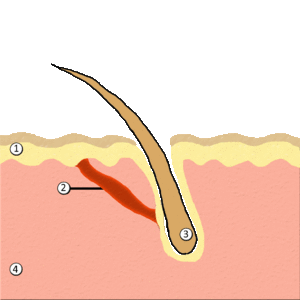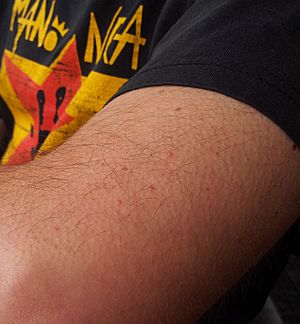Goose bumps facts for kids
Quick facts for kids Goosebumps |
|
|---|---|
| Synonyms | Goose-pimples, goose-skin, goose-flesh, cutis anserina, horripilation, horripilatio |
 |
|
| Goose-bumps on a human arm | |
Goose bumps are those small bumps on your skin. They appear at the bottom of your body hairs. You might feel them when you are cold or have strong feelings. These feelings can be fear, excitement, or even joy.
Goose bumps are a natural body reaction. In humans, it is like a leftover reflex from our ancestors. Long ago, this reflex helped them. It made their body hair stand up. This would make them look bigger to scare away predators. It also trapped more air in their fur. This helped them stay warmer. This reflex is also called piloerection. Many mammals have it. For example, porcupines raise their quills when they feel threatened.
Contents
How Your Body Makes Goose Bumps
Goose bumps happen when tiny muscles pull your hairs straight up. These muscles are called arrector pili muscles. They are found at the base of each hair. This reflex starts because of your sympathetic nervous system. This system controls many "fight or flight" reactions.
Arrector Pili Muscles
Arrector pili muscles (APM) are smooth muscles. They connect your skin to your hair follicles. When these muscles tighten, they trap more air. This helps your body control its temperature. It was once thought that each muscle connected to only one hair. But now we know that one muscle can connect to several hairs. There are also small glands near these muscles. They are called sebaceous glands. They help support the muscles.

Hair Follicles
A hair follicle is like a small pocket in your skin. It is where your hair grows from. The bottom part of the follicle, called the bulb, helps your hair grow.
When Humans Get Goose Bumps
Humans often get goose bumps in many situations. You might get them when you hear a strange sound. Or you might feel them when you watch a scary movie. Some people even get them when they remember strong, happy moments. For example, after winning a sports event.
Some people can even make themselves get goose bumps. They do this without any outside reason. They often describe it as a chill starting from their head. This chill moves down their body. It can also make their heart beat faster. Goose bumps appear mostly on their forearms. Scientists are still studying how this happens.
Goose bumps are often a sign of strong feelings. They show that someone is deeply moved by something. You can see goose bumps most clearly on forearms. But they can also appear on legs, the neck, or other hairy skin areas. Some people even get them on their face or head.
Sometimes, goose bumps can be a sign of certain health conditions. For example, they can be a symptom of some brain tumors. A skin condition called keratosis pilaris can also look like goose bumps.
What Causes Goose Bumps?
Many things can cause goose bumps. They are usually linked to how your body reacts to its surroundings or feelings.
Cold Temperatures
You might get goose bumps when you are suddenly very cold. For example, if you step into a cold room. Your skin tries to warm itself quickly. The tiny muscles attached to your hair tighten. This makes your hairs stand up straight. This helps water on your skin dry faster. It also helps trap a layer of warm air near your skin.
Strong Emotions
Strong feelings can also cause goose bumps. People often say their "hair stands on end" when they are scared. Or when they are amazed by something. When you are in a very stressful situation, your body gets ready to "fight or flee." Your body releases a hormone called adrenaline. This hormone makes your heart beat faster. It also raises your body temperature. Then, the same system makes your hair muscles tighten. This causes the goose bumps.
Music
Listening to music can also give you goose bumps. Researchers in Canada found that when music moves people, their brains react. It's like when they get delicious food or money. This good feeling comes from a chemical called dopamine. Dopamine causes physical changes. These include changes in heart rate, breathing, and skin temperature. The more you enjoy the music, the stronger these changes are. Scientists believe this explains why music is so important to us.
Other Causes
Some medicines or herbal supplements can affect your body temperature. They can also change your blood flow. This might cause you to get goose bumps.
Being Able to Control Them
Some people can make themselves get goose bumps. They discover this ability on their own. It seems to be something they are born with. It is not something you can learn. Many people who can do this do not realize that others cannot. This ability might be linked to certain personality traits. These traits include being open to new experiences.
Where the Name "Goose Bumps" Comes From
The name "goose bumps" comes from how goose skin looks. When a goose's feathers are removed, its skin has bumps. These bumps are where the feathers used to be. Human goose bumps look similar to these.
It is not clear why the goose was chosen for the name in English. Many other birds have the same skin feature. Other languages use different birds. For example, some languages use the hen or chicken. Hebrew uses the duck. In Ukrainian and Russian, they use a word that means "ants crawling on your skin."
See also
- Autonomous sensory meridian response
- Cold chill
- Frisson



